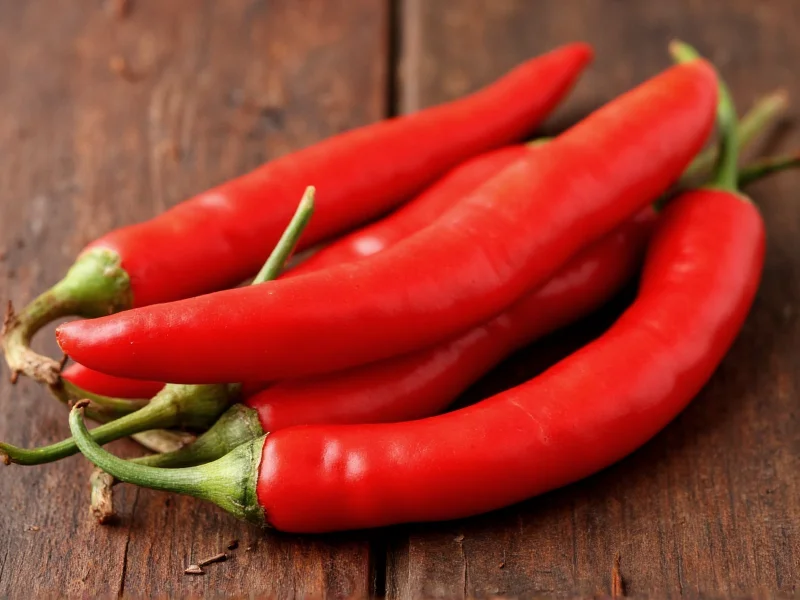When exploring are guajillo chiles hot, the answer lies in their precise position on the Scoville scale. These popular Mexican chiles deliver noticeable warmth without the intense burn of hotter varieties. Understanding guajillo chile heat level Scoville measurements helps home cooks and chefs incorporate them effectively in recipes.
Guajillo chiles originate from the mirasol pepper, which transforms during the drying process to develop its signature deep red color and leathery texture. Unlike many chiles that prioritize heat, guajillos balance moderate spiciness with distinctive flavor notes of green tea, berries, and subtle tanginess. This dual characteristic makes them indispensable in traditional Mexican cuisine, particularly in adobo sauces, mole blends, and salsas.
| Chile Variety | Scoville Heat Units | Heat Comparison |
|---|---|---|
| Guajillo | 2,500-5,000 SHU | Moderate warmth with berry notes |
| Jalapeño | 2,500-8,000 SHU | Sharper, grassier heat |
| Ancho | 1,000-2,000 SHU | Milder, sweeter dried poblano |
| Serrano | 10,000-23,000 SHU | Significantly hotter than guajillo |
| Habanero | 100,000-350,000 SHU | Extremely hot, fruity flavor |
Understanding Guajillo Heat in Culinary Context
When evaluating how hot are guajillo chiles compared to jalapeño, consider that fresh jalapeños can sometimes exceed guajillo's maximum heat. However, guajillos provide more consistent warmth since they're always used dried. The drying process concentrates flavors while maintaining moderate heat levels, making them versatile for dishes requiring noticeable but not overwhelming spice.
Chefs appreciate guajillos for their what do guajillo chiles taste like profile—a sophisticated blend of tamarind-like acidity, roasted tomato depth, and faint floral notes. This complexity explains why they're frequently used in Mexican cooking beyond mere heat contribution. When rehydrated properly (soaked in hot water for 15-20 minutes), they form smooth, rich sauces ideal for enchiladas, tamales, and carne asada marinades.
Practical Usage Tips for Home Cooks
For those wondering are guajillo peppers spicy enough for authentic recipes, the answer depends on your heat tolerance and recipe requirements. Traditional Mexican dishes often combine guajillos with hotter chiles like arbol to achieve layered heat profiles. If substituting in recipes, consider these guidelines:
- For guajillo chile substitute for less heat, use anchos (milder) or pasillas
- To increase heat while maintaining flavor, blend with 1-2 arbol chiles
- Always remove seeds and veins to reduce heat intensity by up to 50%
- Toast dried chiles lightly in a dry skillet before soaking to enhance flavor
Storage and Selection Guide
Select guajillo chiles with deep mahogany color and flexible texture—avoid brittle, faded specimens which indicate age and diminished flavor. Store in airtight containers away from light and moisture for up to one year. For extended storage, freeze rehydrated chiles in ice cube trays for convenient portioning in future recipes.
Common Misconceptions About Guajillo Heat
Many confuse guajillos with similar-looking chiles like California or ancho peppers. While guajillo vs ancho chile heat shows guajillos are noticeably hotter, both share earthy notes. Unlike some chiles where heat dominates, guajillos deliver balanced warmth that complements rather than overwhelms other ingredients. This makes them ideal for dishes where spice should enhance, not dominate, the flavor profile.
FAQ
How does guajillo chile heat compare to common peppers?
Guajillo chiles (2,500-5,000 SHU) are milder than jalapeños (which can reach 8,000 SHU) but hotter than anchos (1,000-2,000 SHU). They provide moderate, approachable heat similar to a mild serrano but with more complex flavor notes of berries and green tea.
Can I reduce guajillo chile heat in recipes?
Absolutely. Removing seeds and inner membranes reduces heat by up to 50% since capsaicin concentrates there. Soaking in milk or citrus juice instead of water also neutralizes some heat compounds while enhancing flavor complexity for those asking how to make guajillo chiles less spicy.
What dishes showcase guajillo chiles best?
Guajillos shine in Mexican red sauces, particularly traditional mole varieties, adobo marinades, and salsa roja. Their moderate heat and complex flavor make them ideal for dishes where spice should complement rather than dominate, such as enchilada sauces, carne asada marinades, and slow-cooked stews.
Are guajillo chiles the same as California chiles?
No, though often confused. Guajillos are thinner with a sharper point and more intense heat (2,500-5,000 SHU) compared to California chiles (500-2,500 SHU). Guajillos have distinctive berry and tea notes, while California chiles offer milder, sweeter flavor preferred for stuffed pepper dishes.
How long do dried guajillo chiles stay fresh?
Properly stored in airtight containers away from light and moisture, dried guajillos maintain optimal flavor for 6-12 months. For extended freshness, freeze them. Discard if they become brittle, lose deep red color, or develop musty odors—signs of diminished quality that affect both guajillo chile heat level and flavor.











 浙公网安备
33010002000092号
浙公网安备
33010002000092号 浙B2-20120091-4
浙B2-20120091-4